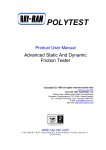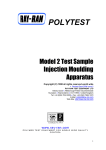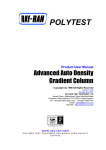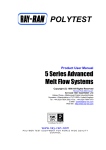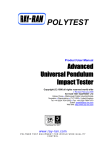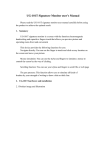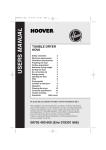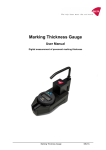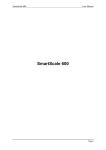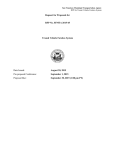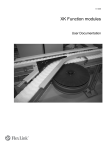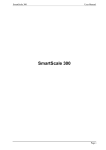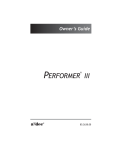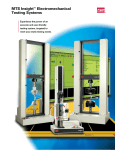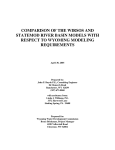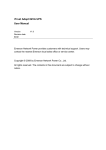Download POLYTEST - Ray-Ran Test Equipment LTD
Transcript
POLYTEST Product User Manual 2 & 4 Station Heat Distortion and Vicat Softening Point Temperature Apparatus Copyright 2001 all rights reserved world wide Revised Nov 2005 version1.07 RAY-RAN TEST EQUIPMENT LTD Kelsey Close Attleborough Fields Industrial Estate Nuneaton Warwickshire CV11 6RS United Kingdom Tel : +44 (0)24 7634 2002 Fax : +44 (0)24 7664 1670 E-Mail : [email protected] Web Site : http://www.ray-ran.com www.r ay-ran. com POLYMER TEST EQUIPMENT FOR W ORLD W IDE QUALITY CONTROL 1 Contents User Manual ................................................................ ............................................................... 3 Introduction................................ ................................................................ ................................ 3 Installation................................ ................................ ................................................................ .. 3 The heating Cycle ................................................................ ...................................................... 4 Heat Transfer Medium (silicone oil) ................................ ......................................................... 4 Overheating Safety Device................................................................ ........................................ 4 Nitrogen Blanket (if supplied)................................................................ ................................... 5 Cooling Circuit ................................ ................................................................ ........................... 5 Dedicated Advanced Microprocessor................................ ...................................................... 5 Software (if supplied) ................................................................ ................................ ................ 6 Displacement Measuring Gauges................................................................ ............................. 7 Test Weights ................................................................ .............................................................. 7 Loading/Removing weights, samples and nibs. ................................................................ .... 7 Test Sample Preparation................................................................ ........................................... 8 Test Procedure................................ ................................................................ ........................... 8 Heat Distortion Test (HDT) ..............................................................................................................................8 Vicat (VST) ................................................................................................................................................... 10 Calibration ................................ ................................ ................................................................ 12 Spare Parts ................................................................ ............................................................... 14 Wiring Diagram ................................ ................................................................ ........................ 15 Ray-Ran Products & Services ................................ ................................................................ 16 2 User Manual Thank you for purchasing the Ray-Ran HDT/Vicat Softening Point Apparatus. Please read this manual before you install or operate the apparatus. All the necessary information for you to perform Heat Distortion and Vicat softening temperature tests has been included in this manual. If however, you have any questions regards the correct use of the machine, then please contact Ray-Ran for technical support. Introduction Test samples are placed into a silicon oil bath which is heated by a submerged electrical element. The samples are then subjected to a known stress or load and the temperature is recorded when the deflection or penetration is reached. The apparatus is then automatically cooled by circulating water through a coiled pipe which runs around the internal perimeter of the tank. The machine has been designed to perform two specific tests on polymer materials in accordance with international Test Standards. These tests are as follows:- Heat Distortion Tests (HDT) The principal of this method of testing is to determine the temperature at which a specified deflection occurs when a standard test sample of plastics is subjected to a specified bending stress produced by a simple three point loading beam, when the temperature is raised at a uniform rate of:Temperature - 120 °C per hour. The deformation is monitored throughout the testing and the temperature is automatically displayed when:HDT test has deflected 0.25 mm Vicat Softening Temperature (VST) The principal of this method of testing is to determine the temperature at which a standard indenter (nib), with a known surface area, penetrates a specific distance into the surface of the test sample under a specified load when the temperature is raised at a uniform rate. Temperature - 50 °C per hour. Penetration is monitored throughout the testing and the temperature is automatically displayed when:Vicat softening point tests have penetrated - 1.0 mm. Installation Electric Power Supply Current – A.C Voltage – 220-240 Phase – Single Frequency – 50 Hz Main Fuse – 10 amps This apparatus is a dedicated piece of laboratory equipment and contains delicate electronic components. The machine must be handled with care when unpacking. Ensure that the components, nibs, weights, etc. are not lost whilst unpacking the equipment. Always drain the heat transfer oil before attempting to lift the apparatus. The apparatus can be comfortably lifted by two people with each person holding opposite ends of the machine and lifting it together. It must then be positioned on a level (sturdy) surface within easy reach of an electrical power 3 supply and a mains water outlet for the cooling procedure. Connect up the water supply to the solenoid valve on the side of the machine. The fittings are ¼ BSP. To fill the tank with a suitable heat transfer medium raise the test stations and place setting block onto top plate of the tank and lower test stations so they rest on setting block. Unscrew the level indicator dipstick on the top plate and poor a suitable heat transfer medium through the hole using a suitable funnel until it covers the lower plate which holds the test samples. IMPORTANT Do not overfill the tank past the level indicator on the dipstick. The Expansion of the silicon oil during the heating process will cause the oil to spill over the top of the tank and into the back cabinet where the electronics are. The Silicone Oil Capacity for the apparatus is as follows: 2 Station – 10 Ltrs 4 Station – 16.32 Ltrs The heating Cycle The heat transfer medium is heated using a tubular sheathed rod heater element, submerged in the fluid and having the following specification Rating – 2.5 Kw Current – 10.42 amps The amount of power delivered to the heater is controlled by the microprocessor to ensure that the temperature ramp rate is maintained within the limits specified. Please note that at the start of each test there is a temperature stabilisation and specimen creep period before the actual test starts. If the apparatus fails to heat up correctly please ensure that the water is not flowing through the cooling circuit. Heat Transfer Medium (Silicone Oil) The recommended Heat Transfer Medium for the Ray-Ran HDT/Vicat is Silicone Oil. Before selecting the grade of Silicone Oil to use it is important to consider your maximum operating temperature and advise your supplier. Special consideration must be given if you are operating near the flashpoint temperature of the oil. In this case we strongly recommend the use of a Nitrogen Blanket. Please consult Ray-Ran for advice. The silicone oil is circulated around the bath using a screw pump system which lifts the oil off the heaters and transfers it to the top of the bath. The continual circulation of the oil ensures that a uniform oil temperature is maintained around the oil bath. This circulation also prevents hot spots and oil waxing around the heater element. Do not use the apparatus if the oil pumps are not working and consult Ray-Ran for technical advice. Overheating Safety Device The apparatus is fitted with an independent electrical cut-off thermostat located on the left hand panel, which will break the electrical circuit should the temperature of the oil exceed its safe working limit. Set the thermostat dial indicator to cut out approximately 20 deg above the anticipated maximum operating temperature of the test procedure. In doing so pay attention to the maximum operating temperature of the silicone oil! 4 Nitrogen Blanket (if supplied) The oil bath is fitted with an inlet pipe located in the oil level dip stick hole and an outlet pipe located in the station plate to enable a nitrogen blanket to be sustained over the heated oil. A manometer is fitted to the outlet pipe to measure the pressure relative to the atmosphere. The nitrogen supply is piped to a pressure regulator located on the right side of the cabinet and an in line flow regulator to the top of the oil bath at the dip stick hole. Operation When testing at temperatures in excess of 260 C, it is recommended that an inert gas (nitrogen) is used as a blanket on top of the oil as a safety factor. 1. Connect a suitable clean nitrogen supply to the inlet port of the pressure regulator. Approximately 3-4 bars will be sufficient. 2. The in line flow regulator should be fully closed at this stage (Screw adjuster clockwise). 3. Remove the black caps from the ports on the top of the manometer. Fit the end of the output tube to the right hand port. 4. Check that the manometer scale pointer (red arrow) is set between 100 and 200pa on the scale. 5. Set the pressure regulator to approximately 3-4 bars. 6. Adjust the in line flow regulator (screw anti-clockwise) very slowly until the red indicator bar on the manometer rises to the correct setting. The red lamp located on top of the main cabinet will illuminate when the flow rate is sufficient to give the correct tank pressure of 100-200 PA. Between 100 PA and 200 PA is sufficient to sustain the nitrogen blanket. 7. Submerge the samples into the tank ready for test and fit the Nitrogen cover over the apparatus. MPORTANT DO NOT open the flow regulator valve too far or too quickly. Excessive flow will blow the liquid out of the manometer and will cause damage to the unit. If using a nitrogen supply from a bottle it is recommended that a low pressure audible alarm is fitted to the outlet valve of the supply. Cooling Circuit A connected water supply should be adequate to cool the system down within a reasonable amount of time. If this is not the case, it may be acceptable to start a test at a higher temperature if it has no effect on the test results in any way. Please refer to your test standard. If this is not acceptable then some form of water cooling may be required. After a test has been completed the microprocessor will start the cooling procedure automatically. If the apparatus is left un-attended or there has been a significant change in the ambient or water temperature during the previous test, the cooling cycle may be unable to cool the apparatus back to the desired starting temperature. In this case a “time out” counter incorporated into the machine will shut the power off after a set period of time. This is to prevent the cooling cycle continuing indefinitely should the required temperature not be reached. Advanced Dedicated Microprocessor The microprocessor has been developed by Ray-Ran over several years as a multi-option network information processor, combining a range of measuring parameters, such as speed, temperature, load and displacement. The basic circuitry is used on all of our microprocessor controlled products and is therefore well tried and tested. The microprocessor uses number identification to input the test parameters using the data entry keypad and simple YES/NO prompts to menu options. The information you give can be seen on entry on the LCD display. There is very little the user has to remember but it is important to input the correct data to give you the correct results. 5 The microprocessor also has the facility to link to a computer or printer via an RS232 connection for results presentation and data file capture. Software (if supplied) The windows based software is compatible with any windows based operating system, from win 95 upwards. The results are displayed in a tabular and graphical format. To install the software, Insert diskette into A: Drive From start menu select Run Type A: setup Select Datalink.exe Or From start menu, Select My Computer Select 3 ½” floppy (A:) Right click Datalink.exe icon and select copy Right click on desktop or selected file Select paste. 6 Displacement Measuring Gauges A series 543 Mitutoyo Digimatic Indicator is used on each station to monitor the deflection/penetration of the test sample. The measurements are shown on the LCD of the gauge and simultaneously transmitted to the microprocessor. Before a test The Digimatic Indicators must be set to metric and the count direction must be set to “REV”. The + - button on the indicator changes the direction of travel. The microprocessor will automatically take whatever reading is showing on the gauge at the start of a test as “the zero start point”. If the operator wishes to observe the deflection of the sample the digimatic indicator can be set to zero at the start of the test. Test Weights HDT test weights are calculated by the microprocessor after the test parameters have been entered and then displayed in the main LCD. The correct weight is selected from the binary weight progression system which covers a range of 1 – 3119 grams in 1 gram increments. The units for the force applied to the test sample for HDT are specified in Newtons. The relationship between force and weight can be seen in the equation:Force (Newtons) = Mass (kg) x Acceleration due to Gravity (9.81m/s/s) Therefore it can be seen that 1 kg = 9.81 Newtons Vicat test weights conform to international test standards. These weights are 1kg and 5kg depending on the material being tested. Loading/Removing Weights, Samples & Nibs The test stations are raised and lowered by hand using the two red handles which slide vertically in bearings. In the raised position, the handles can be locked by turning them together, inwards through 90 deg. Once the station is in the raised position the temperature measuring probe is clear of the oil and therefore not recording the temperature of the oil. This must be remembered when cooling as the temperature needs to be monitored during the cooling cycle The test weights are fitted onto the insulated spigot on the top of the of the displacement rod. Care must be taken when lifting heavy weights. Always add and remove weights when the test stations are in the lowered position. To insert the samples for HDT test. Firstly make sure the HDT nib is fitted to the Displacement Rod. Lift the displacement rod to its uppermost position and place the sample across the support rests. Lower the displacement rod back onto the sample To insert the samples for Vicat test. Firstly make sure the Vicat nib is fitted to the Displacement Rod. Lift the displacement rod to its uppermost position and place the sample on the support plate. Lower the displacement rod back onto the sample To change nibs, Lift the station by hand using the two red handles. In the raised position, the handles can be locked by turning them together, inwards through 90 deg. Using the Allen key provided, loosen the nib from the shaft. Care must be taken not to drop the nib into the oil bath. Slide the new nib fully home and lock the grub screw. Ensure that the position of the HDT head is at 90 ° to the sample bar. Ensure that the correct heads or nibs are fitted to each station shaft for either HDT or VST testing. Please note, the nibs are a direct replacement for each other and therefore, no adjustment is necessary. 7 Test Sample Preparation The sample material must be prepared in accordance with the relevant standard you are testing to. It is recommended that a minimum of two samples be tested during any one test. This will give an indication of any scatter in the test results. For HDT tests, producing an accurate test sample size is very important. Any size variations have a detrimental effect on the resultant fibre stress values. The side faces of the HDT samples must be parallel and square to ensure that the load is acting in a true vertical position relative to the sample. Moulded samples often have tapered faces which prevent the samples from sitting perpendicular to the load. This condition will inevitably affect the accuracy of the test results. For Vicat Tests, the thickness of the test sample should be as recommended by the test standard otherwise the material will not be able to support the load acting on the indenting nib without lateral distortion of the material which will cause the test to terminate prematurely. Test Procedures Heat Distortion Test (HDT) A minimum of two samples must be tested together. Ensure that the load displacement rods are fitted with the 3mm radius ends. Set the thermostat dial indicator to cut out approximately 20 deg above the anticipated maximum operating temperature of the test procedure. Turn on the machine using the power on/off switch located on the left hand side of the apparatus. The switch will illuminate red when the power is on. When the power is on the LCD displays <Warming Up> and the counter will count down from 2 minutes. Turn on the displacement gauges and put in reverse mode by selecting the +/- key on the gauge. <Rev> will be displayed on the gauges LCD If on power up of the machine, the gauges are not turned on or are faulty, or the PRT`s are not plugged in the LCD will display <Station Diagnostics> followed by <G> (Gauge) and <T> (Thermocouple) for each station. The faulty instruments will display an <X> and the functioning instruments will show a <√>. If an <X> appears please check that the relevant instruments are connected and switched on. Press <Re-test> to test the system again. If all <√> are present select <Ok>. If not consult Ray-Ran for advise. Ensure the stations are submerged into the oil bath. LCD displays <Current time & date>. Select <Ok> to continue or <Alter> to amend the time and date. LCD displays <Operator ID number>. Enter a user ID number via the numeric keypad and select <Enter> to continue. LCD displays <Material reference>. Enter a material reference number via the numeric keypad and select <Enter> to continue. LCD displays <Batch reference>. Enter a batch reference number via the numeric keypad and select <Enter> to continue. Please note that the <delete> key on the numeric keypad deletes the entered numeric characters. LCD displays <Select operation> – <Perform test>. Select <OK> to perform a test or <next> for <Calibration mode> or <Abort> See Calibration section for calibrating the apparatus. LCD displays <Select test type> – <HDT>. Select <OK> to perform a test or <next> for <Vicat> or <Abort> 8 LCD displays <Select ramp rate> – <120° C/Hour>. Select <OK> to continue or <next> to change the temperature ramp rate to <50° C/Hour> or <Special>. If <Special> is selected enter the ramp rate required using the numeric keypad. LCD displays <Parameter entry> – <Stations 1 & 2>. Select <Ok> to enter new test parameters or <next> if previous stored parameters are to be used. (in this case go to <Continue test>) If <Ok> is selected and new parameters are to be entered the LCD displays <Station 1 & 2> – <Enabled>. Select <Ok> to continue or <next> to disable station 1 & 2. (option used for 4 station apparatus only) LCD displays <Fibre stress> – <Method A: 1.8 MPa>. Select <Ok> to continue or <next> to display optional fibre stresses. Once an optional fibre stress has been selected select <Ok> to continue LCD displays <Loading> – <Edgewise>. Select <Ok> to continue or <next> to display <Flatwise>. LCD displays <Span support> – <100mm>. Select <Ok> to continue or <next> to change the span support to <64mm>. LCD displays <Deflection> – <0.10mm>. Select <Ok> to continue or <next> to change the deflection to a required depth. Enter your required depth using the numeric keypad. LCD displays <Ensure thickness H is less than width B >. Select <Ok>. LCD displays <Sample thickness>. Select <Ok> if the sample thickness stated is ok or <Alter> to enter a new thickness. Select <Ok> to continue LCD displays <Sample width>. Select <Ok> if the sample width stated is ok or <Alter> to enter a new width. Select <Ok> to continue LCD displays <Parameter entry> – <Stations 1 & 2>. Select <next> to continue or <OK> to re-enter test parameters. LCD displays <Continue test>. Select <Ok> to continue or <next> to abort test. LCD displays <Start temperature 22.0°C> The ambient temperature is also displayed on the LCD. Select <Ok> to continue or <Alter> to alter the starting test temperature. Please note that the temperature (for example) must be entered 025.0°C if below 100°C. If 25 is entered then the apparatus will assume 250°C. The test start temperature may need altering if the ambient temperature of the apparatus is higher than the starting test temperature. Please note that the apparatus will not start a test until its ambient temperature is within at least 2 degree range of the test temperature. LCD displays <Storing Parameters> – <Stations 1 & 2>. LCD displays <Starting Temperature stabilizing> – <Please wait>. The temperature of the bath will increase/decrease to within the test temperature specified. Also displayed is <Abort>. Select this if you wish to abort the test. Please note that the stations must be submerged into the bath at this stage. LCD displays <Test weight required> – eg. <1534 grams>. Select the weights required from the binary weight system supplied. Select <Ok> to continue. At this stage do not put the weights onto the loading rods! LCD displays <Load samples>. Lift the stations from the bath and load the test samples onto the HDT rests. Lower the samples back into the oil bath. Select <Ok> to continue. LCD displays <Add required weights>. Add the required weights to the load rods and zero the displacement gauges by pressing <Origin> on the gauge. Select <Ok> to continue. 9 LCD displays <Initial creep compensation in progress>. After a 5 minute period the test will start and the display will show the test type, ramp rate and the sample deflection as a percentage. When the test is complete LCD will display the temperature at which the defection depth occurred. Select <Done> when the test is finished. The cooling circuit will now come on automatically. LCD displays <Save results> – <Yes> - <No>. Select <Yes> to download test results to your computer or optional printer. LCD displays <Perform another test> – <Yes> - <No>. Select <Yes> to perform another test. If <No> is selected the LCD displays <Downloading batch results>. LCD displays <Cooling circuit switched on>. Select <Abort> turn off the cooling circuit if required. LCD displays <Ok to Abort> – <Yes> - <No>. Select <Yes> to abort or <No> to continue cooling. Vicat Softening Temperature (VST) A minimum of two samples must be tested together. Ensure that the load displacement rods are fitted with the 1mm² diameter indentors. Set the thermostat dial indicator to cut out approximately 20 deg above the anticipated maximum operating temperature of the test procedure. Turn on the machine using the power on/off switch located on the left hand side of the apparatus. The switch will illuminate red when the power is on. When the power is on the LCD displays <Warming Up> and the counter will count down from 2 minutes. Turn on the displacement gauges and put in reverse mode by selecting the +/- key on the gauge. <Rev> will be displayed on the gauges LCD If on power up of the machine, the gauges are not turned on or are faulty, or the PRT`s are not plugged in the LCD will display <Station Diagnostics> followed by <G> (Gauge) and <T> (Thermocouple) for each station. The faulty instruments will display an <X> and the functioning instruments will show a <√>. If an <X> appears please check that the relevant instruments are connected and switched on. Press <Re-test> to test the system again. If all <√> are present select <Ok>. If not consult Ray-Ran for advise. Ensure the stations are submerged into the oil bath LCD displays <Current time & date>. Select <Ok> to continue or <Alter> to amend the time and date. LCD displays <Operator ID number>. Enter a user ID number via the numeric keypad and select <Enter> to continue. LCD displays <Material reference>. Enter a material reference number via the numeric keypad and select <Enter> to continue. LCD displays <Batch reference>. Enter a batch reference number via the numeric keypad and select <Enter> to continue. Please note that the <delete> key on the numeric keypad deletes the entered numeric characters. LCD displays <Select operation> – <Perform test>. Select <OK> to perform a test or <next> for <Calibration mode> or <Abort> See Calibration section for calibrating the apparatus. LCD displays <Select test type> – <HDT>. Select <next> to change to <Vicat> then select <Ok> LCD displays <Select ramp rate> – <120° C/Hour>. Select <OK> to continue or <next> to change the temperature ramp rate to <50° C/Hour> or <Special>. If <Special> is selected enter the ramp rate required using the numeric keypad. 10 LCD displays <Parameter entry> – <Stations 1 & 2>. Select <Ok> to enter new test parameters or <next> if previous stored parameters are to be used. (in this case go to <Continue test>) If <Ok> is selected and new parameters are to be entered the LCD displays <Station 1 & 2> – <Enabled>. Select <Ok> to continue or <next> to disable station 1 & 2. (option used for 4 station apparatus only) LCD displays <Penetration> – <0.10mm>. Select <Ok> to continue or <next> to change the penetration to a required depth using the numeric keypad. LCD displays <Test weight> - <1.00kg>. Select <next> to change the weight to <5.00kg> or <Special> Select <Ok> to continue LCD displays <Parameter entry> – <Stations 1 & 2>. Select <next> to continue or <OK> to re-enter test parameters. LCD displays <Continue test>. Select <Ok> to continue or <next> to abort test. LCD displays <Start temperature 22.0°C> The ambient temperature is also displayed on the LCD. Select <Ok> to continue or <Alter> to alter the starting test temperature. Please note that the temperature (for example) must be entered 025.0°C if below 100°C. If 25 is entered then the apparatus will assume 250°C. The test start temperature may need altering if the ambient temperature of the apparatus is higher than the starting test temperature. Please note that the apparatus will not start a test until its ambient temperature is within at least 2 degree range of the test temperature. LCD displays <Storing Parameters> – <Stations 1 & 2>. LCD displays <Starting Temperature stabilizing> – <Please wait>. The temperature of the bath will increase/decrease to within the test temperature specified. Also displayed is <Abort>. Select this if you wish to abort the test. Please note that the stations must be submerged into the bath at this stage. LCD displays <Load samples>. Lift the stations from the bath and load the test samples onto the Vicat rests. Lower the samples back into the oil bath. Select <Ok> to continue. At this stage do not put the weights onto the loading rods! LCD displays <Initial creep compensation in progress>. LCD displays <Add required weights>. Add the required weights carefully to the load rods and zero the displacement gauges by pressing <Origin> on the gauge. Select <Ok> to continue. The test will start and the display will show the test type, ramp rate and the sample penetration as a percentage. When the test is complete LCD will display the temperature at which the penetration depth was reached. Select <Done> when the test is finished. The cooling circuit will now come on automatically. LCD displays <Save results> – <Yes> - <No>. Select <Yes> to download test results to your computer or optional printer. LCD displays <Perform another test> – <Yes> - <No>. Select <Yes> to perform another test. If <No> is selected the LCD displays <Downloading batch results>. LCD displays <Cooling circuit switched on>. Select <Abort> turn off the cooling circuit if required. LCD displays <Ok to Abort> – <Yes> - <No>. Select <Yes> to abort or <No> to continue cooling. 11 Calibration Ramp Rates The International Test Standards have adopted two temperature ramp rates, 120° C / hour. This has a temperature increase of 12° C / hour +/- 1° C / hour every 6 minutes. 50° C / hour. This has a temperature increase of 5° C / hour +/- 0.5° C / hour every 6 minutes. The temperature measuring device should be accurate within +/- 1° C To calibrate the ramp rates start a dummy test in either HDT or Vicat mode and plot a simple graph using a calibrated thermometer and stop watch. The graph should be plotted temperature against time. Temperature Readings The temperature of each individual test station is measured immediately adjacent to the test station and is why each station has its own PRT. The precise temperature of the test station at any instance along the selected temperature ramp rate can be accurately measured and recorded against deflection / penetration of the test material. Any small variations between the test stations, providing they are within the specified temperature ramp tolerance, will not influence the accuracy and consistency of the individual test results. To measure the sample test temperature, two discrete electrical circuits are combined together in such a way that the accuracy of each circuit can readily be ascertained. The First Circuit is a platinum resistance thermometer (PRT) in which the circuit resistance alters directly proportional to the change in temperature. The accuracy of the PRT is 0° C +/- 0.15° C 100° C +/- 0.35° C 200° C +/- 0.55° C Important. Only use identical replacements on this equipment. Failure to do so will cause serious problems with the electronics. Please consult Ray-Ran for Advise. The Second Circuit connects the PRT to the microprocessor for conversion into digital output for result presentation. The accuracy of this circuit is measured semi-automatically by inserting reference resistances equal to the exact temperature readings into the electronic circuit and checking the accuracy of the readings. The microprocessor automatically makes any small adjustments that may be necessary to bring the system within calibration. Any malfunctions are reported as outside the calibration range. Performing a Calibration Performing a calibration is simple. Follow the on screen prompts until, LCD displays <Select operation> – <Perform test>. Select <next> for <Calibration mode> then <Ok> LCD displays <Select station> - <Station 1>. Select <Ok> to calibrate station 1 or <next> to calibrate <Station 2> (<Station 3> <Station 4> if the apparatus is a 4 station machine). Remove the PRT plug from the cabinet for the station that is to be calibrated. LCD displays <Station 1 cal> - <Attach 100Ω then press ok> insert the 100Ω plug into the socket of the PRT and select <Ok>. LCD displays <Station 1 cal> - <Calibrating> LCD displays <Station 1 cal> - <Attach 174Ω then press ok> insert the 174Ω plug into the socket of the PRT on select <Ok>. Replace the PRT into the socket after calibration. LCD displays <Select station> - <Station 1> Select <Next> until <Station 2> is displayed (or 3 and 4 for 4 station apparatus) then select <Ok>. Follow the calibration procedure as for station 1. After the calibrating station 2 select <Next> 12 LCD displays <Save calibration>. Select <Ok> LCD displays <Perform Test> - <Yes> <No>. (See performing a test) If the apparatus fails the calibration test, repeat the procedure again. If this also fails consult Ray-Ran for advise. Displacement Measuring Gauges The test standard specifies that the deflection indicators are accurate to within +/- 0.01mm. These types of indicators are very simple to calibrate using two calibrated slip gauges of between 3mm and 10mm thick. Performing a Calibration Press the zero button on the indicator face. Lift the nib of the indicator and position the slip beneath it and examine the reading. Repeat with the second slip gauge. Both readings should be within the specified tolerance. If the reading is not within the calibrated limit, consult RayRan. 13 Spare Parts List Like all equipment, minor faults can occur, mainly due to ware and tear, and not a fault of the machine. We have provided a list of spare parts that should you require, are readily available from Ray-Ran. Description Vicat Nib HDT Nib Displacement Rod Insulation Spigot Pump Assembly Displacement Rod Insulation Spigot Pump Assembly Binary Weight System for HDT 1 kg Vicat Weight 5 kg Vicat Weight RS 232 Comms Lead Pump Motor PT 100 PRT Sensor Thermostat PRT Cable Pulley Gear Pulley Belt Digimatic Indicator 1mtr Connecting Cable Solenoid Cooling Valve & Bracket Solid State Relay 25 amp Fuse 10 amp Setting Block Part Number HDV 063 HDV 064 HDV 060 HDV A066 HDV 060 HDV A066 HDV A086 HDV 102 HDV 103 XBE 043 XBE 045B XBE 065 XBE 066 XBE 036 XBPB 001 XBPB 008 XBG 002 XBG 003 XBP 017 XBEH 003 XBEH 050 14 15 Ray-Ran Products & Services Raw Material Evaluation Code RR/5MBA RR/5SA RR/5MPCA RR/DGA RR/BDA LA620P LA230P MA30 MA40 Product Model 5MBA Melt Flow Indexer Model 5SA Melt Flow Indexer Model 5MPCA Melt Flow Indexer 3 Column Density Gradient Apparatus Apparent Bulk Density Apparatus Density Balance including Density Kit (Readability 0.001 g) Density Balance including Density Kit (Readability 0.0001 g) Moisture Balance (Accuracy 1.0 g) Moisture Balance (Accuracy 0.1 g) Sample Preparation Code RR/TSMP2 RR/HCP RR/PCP RR/NC RR/CNC TSC + Standard Product Model 2 Test Sample Injection Moulding Apparatus Hand Operated Test Sample Cutting Press Pneumatically Operated Test Sample Cutting Press Auto Cycle Test sample Notching Cutter Test Sample Profile Cutter Test Sample Cutters Sample Testing Code RR/HDV2 RR/HDV4 RR/HDV6 RR/TAA RR/LTB RR/ESC RR/FSL RR/FSHP RR/IMT RR/FWT RR/FT MD-1 M202 Duroprobe Product 2 Station HDT/Vicat Softening Point Apparatus 4 Station HDT/Vicat Softening Point Apparatus 6 Station HDT/Vicat Softening Point Apparatus Thermal Ageing Apparatus Low Temperature Brittleness Tester Environmental Stress Cracking Apparatus Unrestrained Linear Thermal Film Shrinkage Apparatus Hot Plate Film Shrinkage Apparatus Universal Pendulum Impact Tester Falling Weight Impact Tester Static And Dynamic Friction Tester Analogue Modular Durometer Hardness Tester Digital Modular Durometer Remote Digital Modular Durometer 16
















